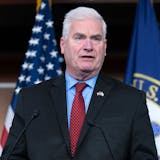The top leader of the Minnesota State higher education system is visiting 20 cities in four days this week to drum up interest in a new scholarship program — and new business for college campuses eager for more students.
Chancellor Devinder Malhotra is hosting media, employers and lawmakers at community colleges across the state to promote the system's workforce development scholarships, which started as a $1 million pilot project this past school year to draw students to high-demand occupations. This spring, the state put up $7 million more toward the program, funding hundreds more scholarships worth $2,500 each for students in manufacturing, agriculture, health care services, information technology, early childhood education and transportation programs.
Malhotra's blitz also comes as Minnesota State leaders are anxiously watching fall enrollment: The system, which recently increased tuition by 3%, is bracing for another enrollment dip after years of declines. Malhotra said he hopes the new scholarships can draw last-minute arrivals on the eve of the fall semester.
"The goal is to get more students who otherwise would not be here," Malhotra said. "If we do our work well — if we raise awareness — more individuals will come and enroll."
Amid shrinking high school graduation classes, the system is by no means alone in dealing with enrollment challenges. But it relies much more heavily on tuition than the flagship University of Minnesota or private campuses and, with its focus on workforce development, it's hit harder when a booming economy keeps workers away.
Officials say the workforce scholarship pilot in 2018-2019 was a success. Almost 400 students took advantage of the program, which covers roughly half their tuition and fees at the system's 30 two-year colleges. Based on preliminary numbers, 90% of those students returned for the spring semester, compared with about 65%, on average, for the system.
"Many of our students come from economically fragile backgrounds," Malhotra said. "They drop out because life happens."
Malhotra said many colleges were able to raise matching funds from local employers and others, allowing them to more fully cover participating students' costs. For example, the White Bear Area Chamber of Commerce and several other groups pitched in to increase the scholarship amount to $3,000 at White Bear Lake-based Century College. Malhotra said he routinely hears from employers desperate for skilled workers for hard-to-fill positions.

